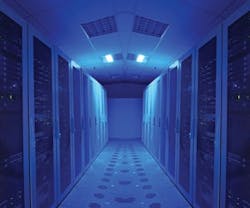Much like the information housed within its walls – both physical and virtual – a data center is unique.
"It’s a different type of facility from the ‘usual’ office building or hospital, particularly with respect to its electrical demands," explains Christopher M. Johnston, PE, critical facilities chief engineer at Syska Hennessy Group, a global consulting, engineering and commissioning firm. "There’s very little change in the power demand over the course of a 24-hour day, and 98 percent of the power usage is dedicated to the computers and the electrical and cooling equipment that support them. Simply put, a data center is either ‘on’ or ‘off.’ "
As facilities professionals, we know that "off" is seldom, if ever, an option. Business continuity is key, which means the only guarantee to ensure uptime all the time is correctly planned and implemented power redundancy. Johnston offers his insight on ensuring the integrity of your data centers through the correct selection and installation of backup generators.
Class Act
Properly maintained, there’s no reason a generator set shouldn’t operate for up to 25 years, explains Johnston, noting the significant impact such longevity has on total cost of ownership (TCO) expectations. Such assumptions, however, are based upon a genset’s annual operating hours, as well as on specifying the correct size (in kilowatts) and the correct class of equipment from among the following three options:
‘Comfort’ in Data Centers
Since data centers are considered an industrial occupancy, personnel comfort is not the first consideration. Air that is pulled in to the front of the unit (the cold aisle) is generally not above 75 degrees; the air coming out the back of the equipment (the hot aisle) is generally 20 to 30 degrees warmer.
"In very high-density computer rooms, we separate the hot and cold aisles physically with hard walls, ductwork, etc., to make the spaces’ cooling operation more efficient," explains Johnston.
For further explanation about and changes in cooling guidelines for data centers, he suggests that facilities professionals turn to documents provided by ASHRAE Technical Committee 9.9 at www.ashrae.org.
-
In theory, a standby-rated genset, the least expensive choice, is operated no more than 200 hours per year. "Normally, people buy standby-rated sets, which are fine for office buildings or hospital environments, because demands go up and down during the day. The difficulty for a data center is that, over a 24-hour period, that set is only capable of providing 70 percent of its rating, on average," explains Johnston.
-
A prime-rated set is heavier duty and presumes an operation of up to 500 hours annually. Once again, oversizing the generators – meaning a 1,000-kilowatt generator will not adequately support a 1,000-kilowatt demand in a data center – is essential to ensure its optimal operation.
-
A continuous-rated set is the most expensive of the three and does just what its name implies; other than maintenance, there is no limitation on the number of operating hours it is capable of providing at full load.
A cautionary note: Be sure to know the air-quality regulations in your area. "In many jurisdictions, you’re not permitted to operate a genset more than 100 or 200 hours a year," says Johnston. "If you’re going to test your generator once a month – maybe eight hours to make sure it’s operating correctly – you will use those hours in testing alone."
Location, Location, Location
Since backup generators are considered a seldom-used, but necessary piece of equipment, many FM professionals believe one set can cover multiple needs (the data center, as well as stairwell lighting, exit signs, and exit lights). "Data centers, whether standalone or as part of an office building or hospital, should have a separate set of generators to support only them," notes Johnston.
Where to site a backup generator is a paramount consideration from day one, due to environmental and permitting requirements. Johnston says he sees roughly equal numbers of in-building and outdoor installations.
As part of your own determination, consider space requirements (the size and access to actual equipment, as well as for on-site storage of diesel fuel); noise and fuel emissions (structural augmentation that assists in noise attenuation and air-quality venting); seasonal changes (access to weatherproof "containers" in bad weather); and security requirements.
Linda K. Monroe is a contributing editor in Cedar Rapids, IA.
